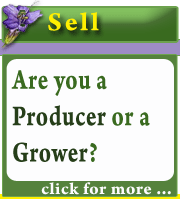Bulk Hydrosols, Bulk Essential Supply, Bulk Herbal Extracts, Herbal Extract Supply, Absolute Essential Oil Supply
Some vanilla growers in Madagascar, the world’s biggest producer of the flavorant, are demanding a minimum price for their crop that would see a return to a marketing system abandoned two decades ago and make their crop less attractive to exporters.
The producers want a floor price to be set at around $27 a kilogram, Claude Andreas, President of Madagascar’s National Platform of Vanilla Exporters, said on Aug. 24 in a telephone interview. That could force up the price of exports to the U.S. by almost a quarter from last year, Craig Nielsen, chief executive officer of Waukegan, Illinois-based Nielsen Massey Vanillas Inc., one of the world’s top five buyers of natural vanilla, said.
“We consider it a mistake to try to fix prices too high. This is what they used to do 20 years ago and it will make it much more difficult for Madagascar to sell its product,” Nielsen, said in an interview. “A minimum export price of $27 per kilogram could add $4-$6 onto the price of the delivered product here in the U.S. In today’s economy it does not make sense.”
The flavorant, which comes from the only edible fruit produced by the orchid family of plants, accounts for a quarter of Madagascar’s export income. Companies including Coca-Cola Co., the world’s largest soft drink company, and Groupe Danone SA, the world’s biggest yogurt maker, use vanilla from Madagascar. Vanilla is also used in perfume.
Representatives of vanilla producers and exporters will meet in Madagascar’s capital, Antananarivo, on Sept. 7 to discuss pricing.
‘Earn Nothing’
“Some operators want to fix a minimum price for Madagascar vanilla,” Andreas said. “This has not yet been agreed among all exporters,” he said, adding that some exporters are in favor of a minimum price.
According to Nielsen, the price for a kilogram of Malagasy vanilla beans delivered to the U.S. in 2008 was $26 to $28 a kilogram. Lower quality vanilla from Papua New Guinea sells for $10 to $12 a kilogram, Nielsen said.
“In other countries the price is free and is driven by agreements with the buyers,” said Andreas, who also represents growers. “Our ideal is to have a competitive price on the world market. We would all like the price to be higher, but if we price ourselves out of the market we will earn nothing.”
Madagascar supplies more than half of the world’s natural vanilla with this year’s crop forecast to be about 1,500 metric tons, according to Andreas. About 80,000 small-scale farmers grow the crop, reaping the vanilla pods by hand from the vine- like plants. The U.S. is the biggest market.
Totonaco Indians, Spanish Conquerors
The use of vanilla originated in Mexico, which dominated trade in the 19th century, according to Nielsen Massey’s Web site. It was used by the Totonaco Indians and later by the Aztecs. Spanish conquerors took vanilla back to Europe.
In 1841, Edmond Albius, a former slave on the island of Reunion, found a way of artificially pollinating vanilla flowers using a bamboo skewer, allowing the industry to develop in Madagascar and other Indian Ocean islands.
Now, almost all of the world’s vanilla now comes from Madagascar and Indonesia. Papua New Guinea and Uganda are also producers while Tahiti produces the flavorant from a different genus of vanilla orchids.
Production from Madagascar and the nearby Indian Ocean islands of the Seychelles, the Comoros and Reunion, is collectively known as Bourbon vanilla. The islands were known as the Bourbon islands.





